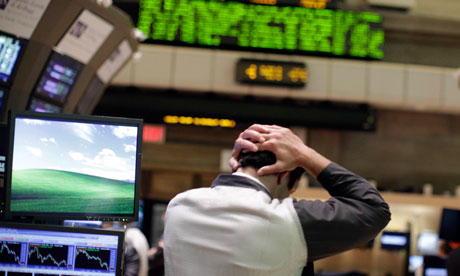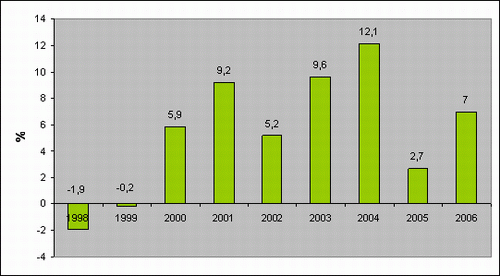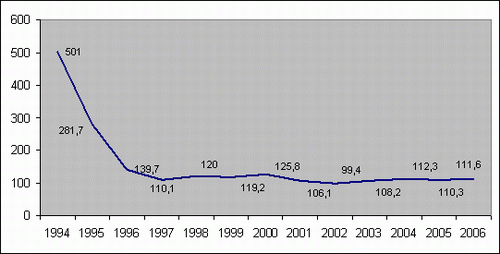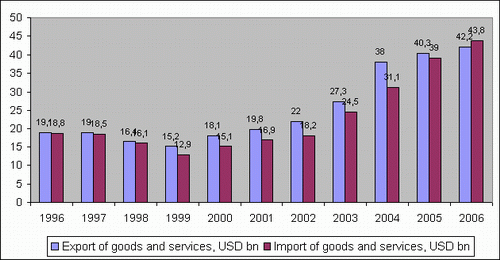
A trader at the New York stock exchange. The last four years have seen five key stages of the global financial crisis, with more likely to come.
9 August 2007. 15 September 2008. 2 April 2009. 9 May 2010. 5 August 2011. From sub-prime to downgrade, the five stages of the most serious crisis to hit the global economy since the Great Depression can be found in those dates.
Phase one on 9 August 2007 began with the seizure in the banking system precipitated by BNP Paribas announcing that it was ceasing activity in three hedge funds that specialized in US mortgage debt. This was the moment it became clear that there were tens of trillions of dollars worth of dodgy derivatives swilling round which were worth a lot less than the bankers had previously imagined.
Nobody knew how big the losses were or how great the exposure of individual banks actually was, so trust evaporated overnight and banks stopped doing business with each other.
It took a year for the financial crisis to come to a head but it did so on 15 September 2008 when the US government allowed the investment bank Lehman Brothers to go bankrupt. Up to that point, it had been assumed that governments would always step in to bail out any bank that got into serious trouble: the US had done so by finding a buyer for Bear Stearn while the UK had nationalized Northern Rock.
When Lehman Brothers went down, the notion that all banks were "too big to fail" no longer held true, with the result that every bank was deemed to be risky. Within a month, the threat of a domino effect through the global financial system forced western governments to inject vast sums of capital into their banks to prevent them collapsing. The banks were rescued in the nick of time, but it was too late to prevent the global economy from going into free fall. Credit flows to the private sector were choked off at the same time as consumer and business confidence collapsed. All this came after a period when high oil prices had persuaded central banks that the priority was to keep interest rates high as a bulwark against inflation rather than to cut them in anticipation of the financial crisis spreading to the real economy.
The winter of 2008-09 saw co-ordinates action by the newly formed G20group of developed and developing nations in an attempt to prevent recession turning into a slump. Interest rates were cut to the bone, fiscal stimulus packages of varying sizes announced, and electronic money created through quantitative easing. At the London G20 summit on 2 April 2009, world leaders committed themselves to a $5tn (£3tn) fiscal expansion, an extra $1.1tn of resources to help the International Monetary Fund and other global institutions boost jobs and growth, and to reform of the banks. From this point, when the global economy was on the turn, international co-operation started to disintegrate as individual countries pursued their own agendas.
9 May 2010 marked the point at which the focus of concern switched from the private sector to the public sector. By the time the IMF and theEuropean Union announced they would provide financial help to Greece, the issue was no longer the solvency of banks but the solvency of governments. Budget deficits had ballooned during the recession, mainly as a result of lower tax receipts and higher non-discretionary welfare spending, but also because of the fiscal packages announced in the winter of 2008-09. Greece had unique problems as it covered up the dire state of its public finances and had difficulties in collecting taxes, but other countries started to become nervous about the size of their budget deficits. Austerity became the new watchword, affecting policy decisions in the UK, the eurozone and, most recently in the US, the country that stuck with expansionary fiscal policy the longest.
Last Friday, the morphing of a private debt crisis into a sovereign debt crisis was complete when the rating agency, S&P, waited for Wall Street to shut up shop for the weekend before announcing that America's debt would no longer be classed as top-notch triple A. This could hardly have come at a worse time, and not just because last week saw the biggest sell-off in stock markets since late 2008. Policymakers are confronted with a slowing global economy and a systemic crisis in one of its component parts, Europe. To the extent that they are united, they are united in stupidity, wedded to blanket austerity that will make matters worse not better. And they have yet to tackle the issue that lay behind the 2007 crisis in the first place, the imbalances between the big creditor nations such as China and Germany, and big debtors like the US.
In the circumstances, it is hard to be wildly optimistic about how events will play out. Markets are bound to remain highly jittery, although it seems unlikely that American bond yields will rocket as a result of the S&P downgrade. Japan lost its triple A rating long ago and has national debt well in excess of 200% of GDP but its bond yields remain extremely low. The reason for that is simple: Japan's growth prospects are poor.
So are America's, which is why bond yields will remain low in what is still, for the time being, the world's biggest economy. The dressing down given to Washington by Beijing following the S&P announcement was, however, telling. Growth rates of close to 10% mean that the moment China overtakes the US is getting closer all the time, and the communists in the east now feel bold enough to tell the capitalists in the west how to run their economies. Whatever it means for financial markets this week, 5 August 2011 will be remembered as the day when US hegemony was lost.
All this is terrible news for Barack Obama. He has not delivered economic recovery. The US is drowning in negative equity and foreclosed homes. No president since Roosevelt has won an election with unemployment as high as it is today. Fiscal policy will be tightened over the coming months as tax breaks expire and public spending is cut. The Federal Reserve only has the blunt instrument of QE with which to stimulate the economy, and will only be able to deploy it after a softening up process for the markets that will take several months. On top of that, Obama will now be branded as the president who presided over the national humiliation of a debt downgrade. He looks more like Jimmy Carter than FDR.
Not that the Europeans should get too smug about this, because what we are witnessing is not just the decline of the US but the decline of the west. One response to last week's meltdown was the announcement of talks between the G7 – the US, the UK, Germany, Italy, France, Canada and Japan – but while this would have been appropriate 20 years ago it is not going to calm markets today. Holding a G7 meeting without China today is like expecting the League of Nations without the US to tackle totalitarianism in the 1930s.
There is no happy ending to this story. At best there will be a long period of weak growth and high unemployment as individuals and banks pay down the excessive levels of debt accumulated in the bubble years. At worst, the global economy will be plunged back into recession next year as the US goes backwards and the euro comes apart at the seams. The second, gloomier scenario, looks a lot more likely now than it did a week ago.
Why? Because there is no international co-operation. There are plans for austerity but no plans for growth. Even countries that could borrow money for fiscal stimulus packages reluctant to do so. Europe lacks the political will to force the pace of integration necessary to avoid disintegration of the single currency.
Commodity prices are coming down, but that is the only good news. We are less than halfway through the crisis that began on 9 August 2007. That crisis has just entered a dangerous new phase.






